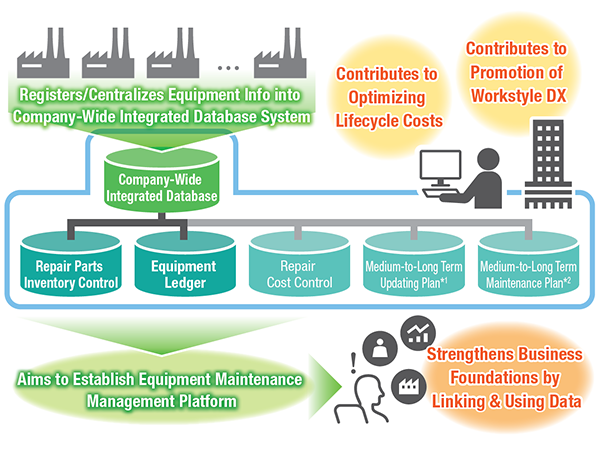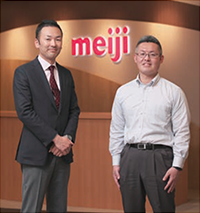Meiji Co., Ltd.
When all factories worked together in using the system, Mr. Komatsu says they set specific numerical goals.
“Our first goal was to reduce overall inventory costs by 10%. Implementing ‘SiteRemix’ allowed us to make detailed checks of inventory, which increased awareness of efforts. Some factories have already achieved the goals they set, so I expect to see a clear reduction effect as we move forward.”
Mr. Hanamura added, “Getting everyone to understand that they could reduce waste if they got involved was a great achievement.
In addition, not only factory equipment environment managers but also manufacturing employees can now check parts at multiple locations from their own computers. This allows them to check which factory has the parts that their own factory needs when they don’ t have them in stock. So now they can get those parts delivered quickly.
It demonstrated its usefulness when electrical components were scarce due to the shortage of semiconductors,” he said as an example of the system performing beyond expectations.
Mr. Komatsu also has hopes for a ripple effect.
“Using the high-level visualization capabilities allows each factory to check the flow of over 60,000 parts in stock at 25 factories, so they can use it as a tool to reviewing their own parts management.
It helps in comparing figures from previous periods and the current period, verifying which parts have increased in number, by how much, and for creating sheets for reviewing parts management.
Ideally, each factory makes these efforts on its own, and now that is actually happening.”


Now that efforts to improve parts management have picked up pace, Mr. Komatsu offered a new vision for the future: “What we are working on is standardizing the work that had been done by each individual factory; in other words, firming up our foundations. In the future, we want to use ‘SiteRemix’ as a comprehensive maintenance management tool. In order to do that, it is essential to update what is standardized and expand the infrastructure.”
Mr. Hanamura said, “More specifically, we aim to visualize not only parts costs, but also maintenance costs as a whole. This will contribute to reducing manufacturing overhead costs and increasing cost competitiveness. It will be more efficient if we roll this out to warehouse and logistics facilities and manage them all with the same system.”
Mr. Komatsu said, “If management at each site improves and becomes more precise, the vision Mr. Hanamura mentioned will become a reality. To achieve this, I hope each and every person will take it upon themselves to work on these problems.
I also hope they take pride in working to contribute to management from the factory floor.” He emphasized that “‘SiteRemix’ is a system for that purpose, and with Mr. Hanamura leading the charge, we will give support and make it even easier to use.”
“SiteRemix” started out simply as a parts management system, but its use is likely to play a variety of roles in the future and contribute as a comprehensive maintenance management tool.
In terms of expectations for Hitachi Power Solutions in the future, Mr. Hanamura said, “We are building up a cumulative database of data related to equipment repair costs, with parts management as the starting point. We look to use this data to create a system of ever greater improvements. Hitachi Power Solutions has an extensive track record of implementations, and we appreciate getting advice on how to improve our systems, including through case studies of other companies.”
Mr. Komatsu added, “‘SiteRemix’ is a tool for improving manufacturing in Japan and revitalizing the Japanese manufacturing sector.
Hitachi Power Solutions is a partner that transcends the order-receiving relationship and looks to move forward by improving things via the exchange of ideas.”
In the next stage, Hitachi Power Solutions will support the food manufacturing industry with its ability to propose technology-based solutions aligned with the desires of its customers.

Meiji Co., Ltd.